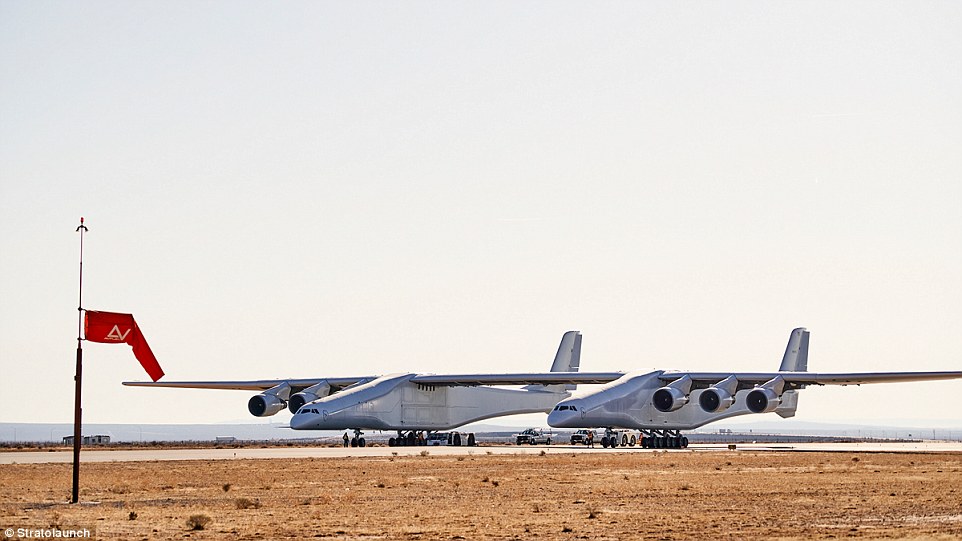The world’s largest plane is a step closer to its first flight after passing another major milestone.
Named Stratolaunch, the aircraft – which has a wingspan longer than a football field – sped down the runway at 40 knots (46mph/74kph) in its latest low-speed taxi test, firing all six of its 8,940lbs (4,000kg) engines.
Once testing is complete, the aircraft will help to fire satellites and other objects into space, including a ‘Dream Chaser’ spaceship that could shuttle astronauts or payloads to and from low Earth orbit within 24 hours.
The Stratolaunch, which is so large it needs twin fuselages each equipped with its own cockpit, is expected to take to the skies for the first time in 2019.
The main purpose of the latest test, which took place at California’s Mojave Air and Space Port, was to put the aircraft’s ability to steer and stop through its paces.
A ground team from Stratolaunch Systems Corp monitored a number of systems, including steering, braking, anti-skid and telemetry.
Engineers conducted the aircraft’s first low-speed taxi test in December, but during this run the vehicle only hit 25 knots (28mph/45km/h).
The plane is the vision of Microsoft co-founder Paul Allen who wants it to act as a giant air pad in the sky, allowing payloads to reach space faster and at a lower cost than existing technologies.
In a statement on Twitter, Allen wrote: ‘Captured new video of @Stratolaunch plane as it reached a top taxi speed of 40 knots (46 mph) with all flight surfaces in place on Sunday. The team verified control responses, building on the first taxi tests conducted in December.’

When the aircraft is eventually airborne, the three-person crew – pilot, co-pilot and flight engineer – will sit in the right-hand fuselage, steering the plane a fair distance to the right of the centerline.
The left-hand fuselage has what looks like a cockpit with windows to onlookers, but the section is in fact empty and unpressurised.
The Stratolaunch weighs approximately 500,000 pounds without any cargo, and designed to carry a maximum takeoff weight of 1.3 million pounds, according to The Verge.


The plane rolls around with the aid of 28 wheels, and once airborne will be powered by six 747 aircraft engines.
The size of the plane will enable it to serve as an airborne rocket launcher.
Traditionally, satellites and other aircraft have been launched into space from a launchpad, which requires a tremendous amount of fuel.

The Stratolaunch, on the other hand, will enable rockets to have a ‘head start’ since they will be carried into the sky before they launch into space.
Since its first engine runs in September, the Stratolaunch team has performed a series of engine tests from a newly established Stratolaunch Mission Control Center (MCC) located at the Mojave Air and Space Port.
The MCC serves as the Seattle-based firm’s hub for testing communications and will eventually be the centre of its aircraft and launch operations.


Once low-speed taxi tests have been safely completed, the company will begin the next phase of taxi testing, which will include increased speeds.
The company completed the first of these tests in December.
As with last week’s taxi run, the aircraft fired up all six of its Pratt and Whitney turbofan engines – each weighing 8,940lbs (4,000kg).













